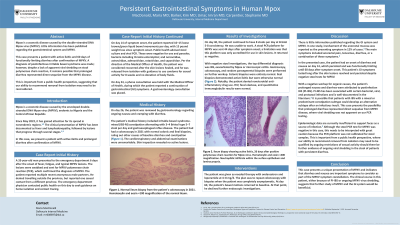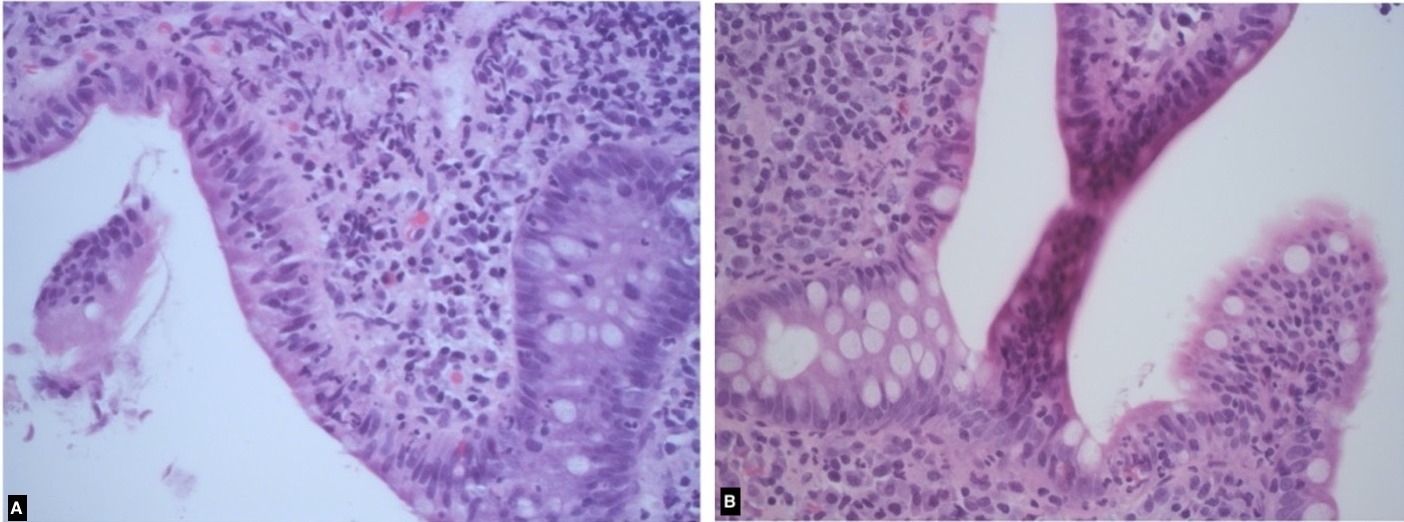Tuesday Poster Session
Category: Colon
P3137 - Persistent Gastrointestinal Symptoms in Human Mpox
Tuesday, October 24, 2023
10:30 AM - 4:00 PM PT
Location: Exhibit Hall

Has Audio
.jpg)
Maria C. MacDonald, MD
Memorial Medical School
St. John, NB, Canada
Presenting Author(s)
Maria C. MacDonald, MD1, Kim Barker, MD2, Imran Umar, MD3, Stephanie Carpentier, MD, FRCPC4
1Memorial Medical School, St. John, NB, Canada; 2Horizon Health Network, St. John, NB, Canada; 3Dalhousie University, St. John, NB, Canada; 4Memorial Medical School/Dalhousie Medical School, St. John, NB, Canada
Introduction: Despite the recent spread of monkey virus (MPXV) in non-endemic regions, little information has been published regarding the gastrointestinal (GI) system and MPXV. This case highlights that diarrhea is an important symptom to consider as part of the MPXV symptom constellation.
Case Description/Methods: A 33-year-old male presented to the emergency department six days after the onset of fever, fatigue and typical MPXV lesions. Diagnosis of MPXV was confirmed with polymerase chain reaction (PCR). The patient reported multiple recent anonymous male partners. On day 14 of symptom onset, the patient reported 10-15 loose brown/green liquid bowel movements per day, with 15-pound weight loss. Public health advised stool culture and viral PCR. These were negative for ova and parasite, bacteria including Yersinia enterolytica, noro-, astro-, adeno-, rota- and sapoviridae.
With a continuation of his GI symptoms, a stool PCR platform for MPXV was sent 44 days after symptom onset; a limitation was that this platform was only accredited for use in skin lesions. It returned as negative. Gastroscopy, colonoscopy, and random pan-segmental biopsies were performed on further workup. Colonic biopsies were entirely normal. Ileal biopsies demonstrated active ileitis but were otherwise normal. HIV, fecal elastase, and quantitative immunoglobulins were normal. The patient was given as-needed therapy with ondansetron and loperamide. The plan was to repeat the colonoscopy with biopsies when the patient was completely asymptomatic. At day 60, the patient’s bowel motions returned to baseline. At that point, he declined further endoscopic investigations.
Discussion: With a negative workup for organic causes, the patient’s prolonged nausea and diarrhea were attributed to post-infection irritable bowel syndrome (PI-IBS). This case presents the possibility that prolonged diarrhea represented direct sequelae from MPXV. Although the stool PCR test for MPXV was negative in this case, this should be interpreted cautiously, as the PCR platform was not calibrated for stool samples. This is important from a public health perspective, where our ability to recommend removal from isolation may need to be adjusted should there be further evidence of ongoing viral shedding in the stool of patients with persistent diarrhea. The clinical course in this patient, due either to PI-IBS or ongoing MPXV virus shedding, suggests that further study of MPXV stool viral shedding may help inform care in MPXV patients with symptomatic diarrhea.

Disclosures:
Maria C. MacDonald, MD1, Kim Barker, MD2, Imran Umar, MD3, Stephanie Carpentier, MD, FRCPC4. P3137 - Persistent Gastrointestinal Symptoms in Human Mpox, ACG 2023 Annual Scientific Meeting Abstracts. Vancouver, BC, Canada: American College of Gastroenterology.
1Memorial Medical School, St. John, NB, Canada; 2Horizon Health Network, St. John, NB, Canada; 3Dalhousie University, St. John, NB, Canada; 4Memorial Medical School/Dalhousie Medical School, St. John, NB, Canada
Introduction: Despite the recent spread of monkey virus (MPXV) in non-endemic regions, little information has been published regarding the gastrointestinal (GI) system and MPXV. This case highlights that diarrhea is an important symptom to consider as part of the MPXV symptom constellation.
Case Description/Methods: A 33-year-old male presented to the emergency department six days after the onset of fever, fatigue and typical MPXV lesions. Diagnosis of MPXV was confirmed with polymerase chain reaction (PCR). The patient reported multiple recent anonymous male partners. On day 14 of symptom onset, the patient reported 10-15 loose brown/green liquid bowel movements per day, with 15-pound weight loss. Public health advised stool culture and viral PCR. These were negative for ova and parasite, bacteria including Yersinia enterolytica, noro-, astro-, adeno-, rota- and sapoviridae.
With a continuation of his GI symptoms, a stool PCR platform for MPXV was sent 44 days after symptom onset; a limitation was that this platform was only accredited for use in skin lesions. It returned as negative. Gastroscopy, colonoscopy, and random pan-segmental biopsies were performed on further workup. Colonic biopsies were entirely normal. Ileal biopsies demonstrated active ileitis but were otherwise normal. HIV, fecal elastase, and quantitative immunoglobulins were normal. The patient was given as-needed therapy with ondansetron and loperamide. The plan was to repeat the colonoscopy with biopsies when the patient was completely asymptomatic. At day 60, the patient’s bowel motions returned to baseline. At that point, he declined further endoscopic investigations.
Discussion: With a negative workup for organic causes, the patient’s prolonged nausea and diarrhea were attributed to post-infection irritable bowel syndrome (PI-IBS). This case presents the possibility that prolonged diarrhea represented direct sequelae from MPXV. Although the stool PCR test for MPXV was negative in this case, this should be interpreted cautiously, as the PCR platform was not calibrated for stool samples. This is important from a public health perspective, where our ability to recommend removal from isolation may need to be adjusted should there be further evidence of ongoing viral shedding in the stool of patients with persistent diarrhea. The clinical course in this patient, due either to PI-IBS or ongoing MPXV virus shedding, suggests that further study of MPXV stool viral shedding may help inform care in MPXV patients with symptomatic diarrhea.

Figure: Ileum Biopsy Showing Active Ileitis, 26 Days After Positive Polymerase Chain Reaction for MPXV.
H&E 400X Magnification
Neutrophilic infiltrate within the surface epithelium and lamina propria
H&E 400X Magnification
Neutrophilic infiltrate within the surface epithelium and lamina propria
Disclosures:
Maria MacDonald indicated no relevant financial relationships.
Kim Barker indicated no relevant financial relationships.
Imran Umar indicated no relevant financial relationships.
Stephanie Carpentier indicated no relevant financial relationships.
Maria C. MacDonald, MD1, Kim Barker, MD2, Imran Umar, MD3, Stephanie Carpentier, MD, FRCPC4. P3137 - Persistent Gastrointestinal Symptoms in Human Mpox, ACG 2023 Annual Scientific Meeting Abstracts. Vancouver, BC, Canada: American College of Gastroenterology.

